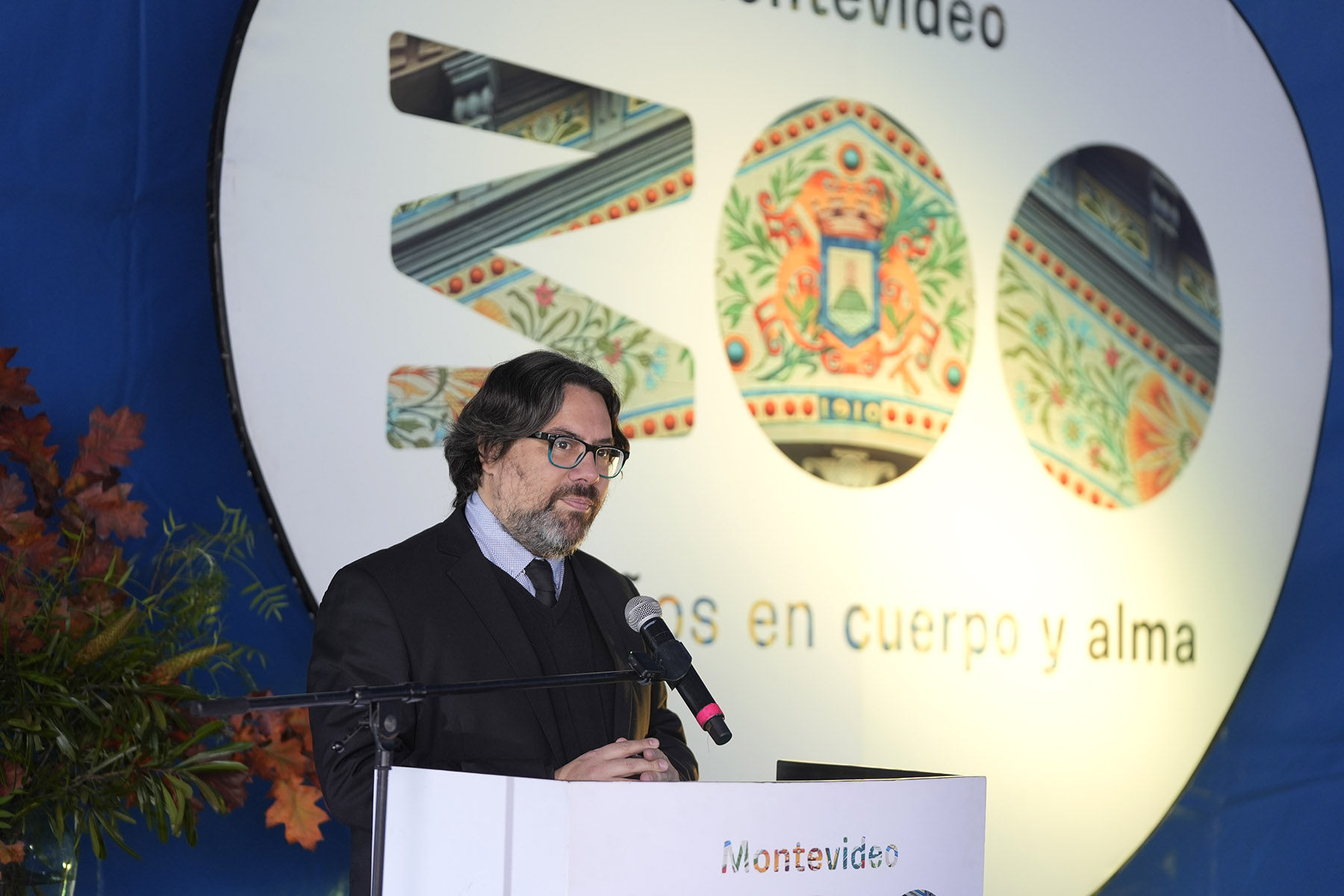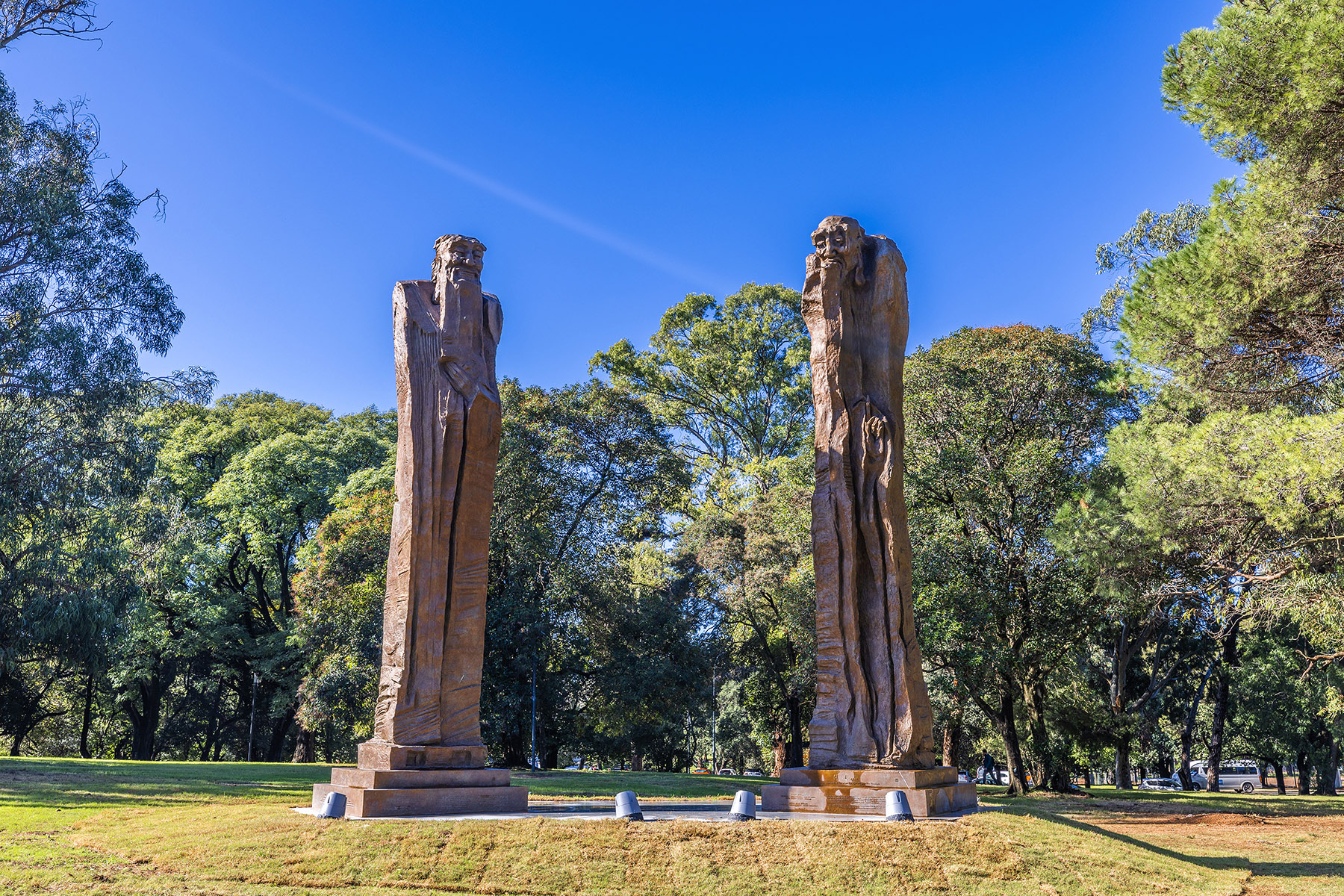
Two bronze sculptures of the great Chinese philosophers Confucius and Lao Tzu were recently unveiled at Batlle Park in Montevideo, the capital of Uruguay.
The artwork, In Search of Wisdom — Confucius Asking Lao Tzu About the Tao, consists of two figures standing 7.8 meters tall and weighing 6.6 tons. It is a masterpiece by renowned sculptor Wu Weishan, who is the curator of the National Art Museum of China.
"The sculptures are the tallest and farthest-traveled pieces of all my works abroad," Wu says, emphasizing that the great sages of Chinese history transcend national boundaries, belonging not only to China but also to the world. "I want the world to see more Chinese figures standing tall."
The base of the artwork bears inscriptions narrating the story behind the sculptures in both Chinese and Spanish. The sculptures show Confucius asking Lao Tzu about the Tao, a central idea in Taoism. Both men lived more than two millennia ago.
The Tao represents the fundamental nature and source of the universe, and encompasses the underlying order and flow of all life.
During her visit to China in 2018, then vice-president of Uruguay Lucia Topolansky made a special trip to Wu's studio. Immediately captivated by the sculptures, she told Wu that she hoped his pieces would find a home in Uruguay in the hope of exposing future generations to the historic dialogue between these two momentous figures.
READ MORE: Chinese culture enthralls people in Finland, Estonia
Six years later, the sculptures crossed the ocean and were placed among the trees in Batlle Park. When they were slowly lowered from a giant crane and finally touched the ground, Wu, who was watching the proceedings remotely, was extremely excited.
"The two sages have left their homeland, but they are not alone. They have kindred spirits all over the world who enjoy hearing them speak about benevolence, the Tao, and virtue," he says.
Over the last 2,000 years, the teachings of Confucius have spread to East Asia, Europe, and the Americas, leaving their mark the world over.
In the 16th century, Italian missionary Matteo Ricci translated the Confucian classics, known collectively as The Four Books, into Latin, and introduced them to Europe, sparking a wave of "Confucianism fever "and providing intellectual support for the European Enlightenment.
Lao Tzu's Tao Te Ching is one of the most widely translated Chinese classics. According to American Sinologist Misha Tadd, it has been translated into 97 languages, and appeared in 2,052 versions.
"The sculptures tell the story of Confucius and Lao Tzu seeking and sharing wisdom. In reality, this is also the relationship between China and the world," Wu says.
The sculptor explains that China first seeks wisdom from the world, saying that he aspires to demonstrate the Chinese people's modesty and curiousness through his work.
"At the same time, I hope to make Chinese culture known to the rest of the world, helping it expand and integrate with other cultures. This process itself is also sharing wisdom," Wu says.

Montevideo Mayor Mauricio Zunino says the sculptures showcase China's profound cultural heritage, and embody great wisdom and value.
The two sages from 2,500 years ago have become a new feature in 300-year-old Montevideo, introducing a new cultural experience to visitors, he says, adding that it will strengthen cultural exchange between China and Uruguay, making the two countries intimate friends.
In the 1990s, while touring museums and antique markets in Western countries, Wu noticed that many of the depictions of Chinese people in art were outdated, rigid, and even deliberately caricatured. The stereotypes deeply saddened him.
Since then, he has been determined to create sculptures depicting outstanding figures from Chinese history, and to introduce these images to a global audience, showing the indomitable spirit and enterprising energy of the Chinese people.
To date, Wu has created over 600 sculptures of prominent figures in the fields of art, culture and science, more than 60 of which have been installed in 30 countries and regions worldwide.
His work includes ancient sages like Confucius, Lao Tzu, and Tang Dynasty (618-907) poet Li Bai, as well as pioneers of cultural exchange such as the monk Jianzhen, and Zen Master Yinyuan Longqi.
"There should be dignified Chinese figures standing tall in the world," says Wu. "These sculptures do not speak, but their images serve as a silent language and are symbols of Chinese culture."
In July 2022, Wu's bronze statue of Jianzhen, who is known as Ganjin in Japan, was unveiled at Shinobazu Pond in Tokyo's Ueno Park. The sculpture depicts the monk, who made six journeys to Japan to spread Buddhist teachings and Tang Dynasty culture, and who lost his sight during a stormy voyage.
According to Japanese seal carver Myohseki Shimura, the sculpture powerfully conveys the spirit of the blind monk, whose heart sees clearly. "It deeply moves everyone who sees it."
Wu voices confidence that sculptures depicting the inner virtues of Chinese culture are appreciated by everyone. "Seeing more of my dignified Chinese sculptures overseas fills me with joy. It's not only recognition of my work but also a testament to China's greatness."
Nikos Kazantzakis, the late giant of modern Greek literature who visited China twice, once said that "Confucius and Socrates were two masks that covered the same face of human logic".
More than 2,000 years ago, many philosophical and literary giants emerged during the golden age of ancient Greece. Among them was Socrates, who was often seen at the Agora in Athens, then a marketplace at the foot of the Acropolis, debating with thinkers, writers and politicians and communicating his ideas.
Roughly at the same time in China, far on the other side of the Eurasian continent, the period of ideological flourishing among the Hundred Schools of Thought — most notably Confucianism — was underway.
Wu's artwork, Divine Encounter — Dialogue between Confucius and Socrates, which now stands in the remains of the ancient Agora, has brought the Chinese sage to the Greek philosopher's hometown.
ALSO READ: Uruguayan photographer captures free-spirited gauchos
The statues of the two great philosophers from the East and the West stand side by side as if they have crossed the boundaries of geography and time and are having an exchange of ideas.
"Their intellectual worlds are connected. One emphasized the world of great harmony and advocated the idea that within the four seas, all men are brothers, while the other discussed the ideal form of state and sought to establish a just and orderly society," Wu says.
"This 'dialogue' between them symbolizes a new stage and a new model of cultural exchange and integration between the East and the West," he adds.
Apart from dialogue between philosophers from different cultures, there is also dialogue between artists.
Another artwork of Wu's, depicting Leonardo da Vinci in dialogue with Qi Baishi, is on display in Vinci, the town in the Italian province of Florence, which was the Renaissance master's birthplace.
"Mutual understanding among people comes from the dialogue of ideas," Wu says, adding that through dialogue between civilizations, different countries and ethnic groups can communicate thoughts, share emotions, enhance understanding, and seek common development.


